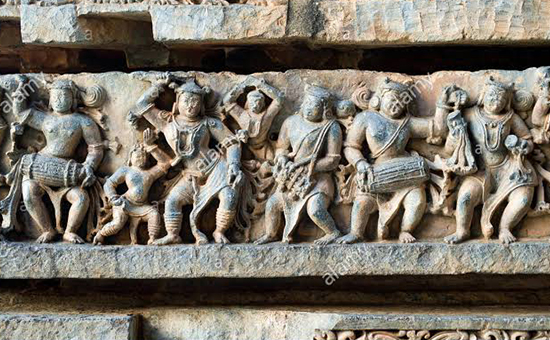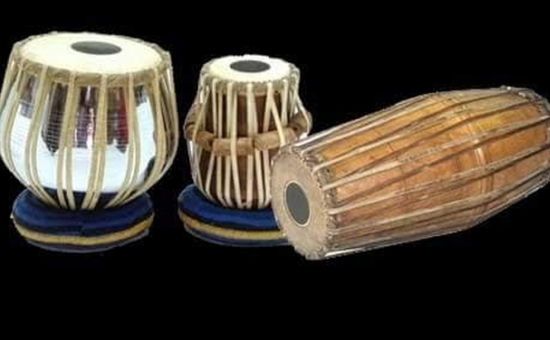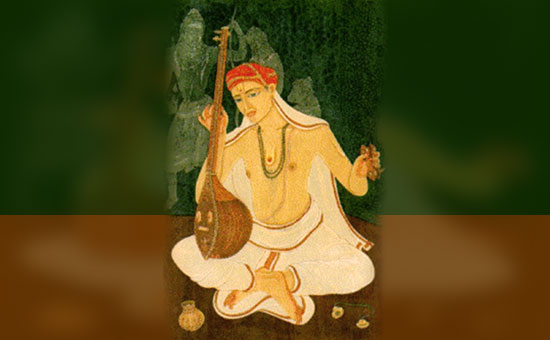As a connoisseur of music the author tells
about fundamentals similarities, origin of Hindustani music, time theory of
ragas, gender based ragas, use of Table and Violin and mostly Carnatic is
devotional Hindustani is romantic.
A LOVER of Carnatic music who is not familiar with Hindustani music is often intrigued by the beguiling affinities or the ‘jarring’ aberrations of the latter. Versatile artistes like Balamurali Krishna or M. S. Gopalakrishnan do often transport the South Indian audiences to the borders of North Indian music, in their tantalising rendering of some ragas.
In the case of M. S. Gopalakrishnan, he
not only interprets a raga totally in
the North Indian technique but also has shown his familiarity with both types of
music and emerged as the leading violin soloist in both Carnatic and Hindustani
music. He now straddles both systems with uncanny ease.
The fundamental
similarities of both types of music are that they are based on the raga structure and that the alphabetical system for the various notes Sa Ri Ga Ma etc. is the same. Both are melodic in nature and the standard scale and a twelve notes-to-an—octave exist in both (although, in Carnatic music, four more nominal notes have been added for good measure).
The terms Camatic music and Hindustani music are first noted in Haripala’s work Sangitasudha-kara written between 1309 and 1312.
First published in Journal of Bharatiya
Vidya Bhavan in 1980.
The Muslim invasions from central and
western Asia resulted in many emigrants fleeing from North India to the South,
one of them being Sarangdeva in the 13th century who was the author of the
monumental work Sangeetaratnakara. There is no indication in his work that two different
systems of music existed in India at that time.
The real bifurcation of Indian music was
actually taking place because of the vaulting intellect of Amir Khusru, a scholar in Persian, Brij Bhasa and
Sanskrit (his mother was a Hindu and his father, a
Persian). Amir Khusru (1254-1324) was a courtier to 11 rulers of the
Khilji dynasty.
He revolutionised the music as it
existed in the North during his time innovating the Khayal, Taraanas, Ghazal,
Dohe, quawalis, etc. inventing the sitar and the
tabla (out of the veena and the mridangam) and infusing an element of Persian music into Indian‘ music, without the latter losing its identity.
 Sculpture with a musical procession with Mridanga.
Sculpture with a musical procession with Mridanga.
There are ragas in Caratic and
Hindustani music with similar names and notes (Khamas: Khamaj, Jenjuruti,
Jinjhoti), those with similar names but different notes (Hindolam: Hindol,
Kedaram: Kedara) and, yet again, those with different names and the same notes
(Mohanam: Bhoop, Nalinakanti: Tilak Kamod, Hindolam: Malkaus).
While the framework of the raga system
in the South is in the 72 basic scales of the Mclakartas perfected in the 17th
century and the janyas of these, in the Hindustani system, it was Pandit V. N.
Bhatkande who, a few decades ago, enunciated his theory which rests on 10 melas or thats based on the Bilawal or
the Shuddha notes which are as follows: Bilawal, Khammaj, Kali, Asavri,
Bhairav, Bhairavi, Kal- yan, Mama, Poorvi and Todi.
Ustad Bade Ghulam Ali Khan, however, a
few years ago, demonstrated his belief, in an interview, that there could not
possibly be more than six basic thats. Using the Bilawal scale (Shankarabharanam)
he showed that, by shifting the sruti one note higher each time, one got Kafi
Bhairavi, Yaman, Jinjhoti and Jaunpuri. He also showed that, using the Ni, the
seventh note, as the Shruti it is not possible to get a that because one gets two Madhyams, but not a straight Pancham
which is essential to form a that. Whatever the categorisation of ragas, there
is no doubt that both Carnatic and Hindustani music continue to be members of
the same family.
Quite naturally, both systems set great
store by certain theories, not necessarily accepted mutual1y. Take, for instance, the time theory in Hindustani music
which specifies that certain ragas can only be performed at certain particular
hours of the day or night, the pivotal note being the Madhyam, a shift from Shuddha Madhyam, to Teevra Madhyam, determining whether a raga can be heard during mid-day to midnight or mid-night to mid—day!
For a person familiar with Carnatic
music, this may, naturally, appear quaint because it is not based on any
scientific principles and cannot be justified except on psychological grounds.
How also could one lay down a rule to the effect that, Deshkar should be a morning raga and that Bhoop should be an evening raga? Both are pentatonic and both have
the same notes, (similar to Mohanam emphasise the Ga, while in the case of
Deshkar, the emphasis should be on the Dha!
Again, as a musicologist has very
pertinently asked, how could there be a mixed raga called Bhairav-Bahar where
Bhairav is a morning raga and Bahar is a late-night raga?
There is, in
North Indian music, a further sub-division of ragas into genders- Ragas and
Raginis. This, again, would appear to be based on emotional rather than
on scientific grounds except to those who think that genders in a language for
neutral objects are perfectly natural! The writer was told by Ustad Bade Ghulam
Ali Khan that a morning raga normally has a corresponding evening ragini or vic
versa, the fundamental difference being that the ragini uses gamaka notes instead of the straight
notes normally associated with ragas e.g. Deshkar vis-a-vis Bhoop, Mooltani
vis-a-vis Todi etc.
As far as instrumental
music is concerned, while in Carnatic music, the instrumental style
closely follows the vocal style, in the North, the instrumental style is quite
distinct and, in fact, there are special compositions for them, called gats.
Needless to say, the gayaki style of the great Ustad Vilayat Khan is an exception.
The development of a raga by an
instrumentalist in Hindustani music in a concert also varies from the vocal
style. A sitar recital, for instance, will begin with an alap, a leisurely unravelling of the raga on the gesthalt system.
Here, the left hand, and, therefore, the slow meends and gamkas, are dominant.
This is followed by a iode, where the tempo is slightly, but palpably, increased
and the plucking hand shows indications of claiming equal rights.
After this comes the Jhala. Here the tempo is not only
stepped up further, but the supplementary strings or chikaris tend to dominate.
It must be mentioned, however, that during all these progressions, although
there is a definite rhythm element, there is no tala and, therefore, no tabla
accompaniment.
An artiste may end the exposition the
raga at this stage, or he may start with a gat in the same raga, when the tabla
enters, normally, with quite a flourish. The tabla, in fact, plays quite an important
role in a sitar or sarod recital, and the question-answer sequence between them
is quite stimulating. The tempo gets faster and faster and often, the ending,
although not necessarily melodious, is quite climactic and, it would appear,
aimed straight at the gallery!
A Word about the tabla may not be out of place here. While, in Carnatic music,
the musician keeps the tala with his hands and the mridangam is more of an
accompaniment, especially if he is a mediocrity, in Hindustani music, it is the
tabla which performs this important function for the musician, and, esp in the vilambit sequence or bada khyal, where
each matra or cycle of a tala could take quite a time to be completed, the
musician may be said to be dependent on the tabla player, to enable him to come
to the all important sam.
Now, turning to a vocal music concert, the musician usually opens
with a bada khyal (unless the singer belongs to the Dhrupad style of singers,
the great style which reached its peak in the 15th and 16th centuries, and had,
among its luminaries, singers of the calibre of Haridas, Tansen, Baiju Bawra),
in which he starts with an alap using the nom toms as syllables with a rhythm
of its own, very similar to the fed and jhala of the instrumental style.
 Tansen tomb Gwalior. He was born to Brahmin parents, Laxmi bai and Makarand
Pandey.
Tansen tomb Gwalior. He was born to Brahmin parents, Laxmi bai and Makarand
Pandey.
Khyal is actually a Persian word, meaning, an ‘idea.’ It has two parts, the asthayi, sung in the lower and the middle octaves and the antara, sung in the middle and upper octaves, but both are complementary to each other.
The bada khyal is always sung in a slow
tempo (vilambit). This is followed by
a chota khyal in the same raga in the madhya laya or drut laya. During these,
he demonstrates his skill in the depth and range of his voice, gamakas, in tans
which are combination or succession of notes in medium or quick tempo, laya
alaps, using vowels, bol-alaps, using the words of the composition, like in
niraval, sargams, which are similar to swaraprasthanas
etc., but always coming back to the sam or the first beat of the tala cycle
after each improvisation. After the drut khyal the musician may choose to sing
a tarana, which is like a tillana — basically, imitations of the sound of a plucked or a percussion instrument played in a fast tempo.
 Mridang and Tabla.
Mridang and Tabla.
He may end his concert, depending on the
duration of it, with a Thumri. A Thumri has no counterpart in Carnatic music; it
is a romantic lyrical piece normally in ragas like Kafi, Pilu, Mand, Khammaj,
etc. The musician is permitted to be a bit way ward here.
He may well proceed to follow Up the khyal with a tappa. Not many are quite adept at it, though. It is believed that this form evolved from the songs of the camel-drivers of the North West of this sub—continent and consists of breath-taking sequen ces of very fast bol-alaps after bol-alaps.
A concluding piece of a concert could
also be a Bhajan. The raga chosen for the concluding item by many musicians,
but not necessarily, is Bhairavi like say, Madhyamavati in Carnatic music.
Many ragas of Carnatic
music have been adopted by Hindustani music in recent years. The late Abdul Karim Khan who brought recognition to the Kirana Gharana just a generation ago, even recorded on discs two South Indian ragas — Saveri as well as the Kriti Ramani Samana in Kharaharapriya.
The pioneering and most prominent
adaptation in recent years has been the almost literal transliteration of Hamsadhwani by the late Ustad Aman Ali
Khan of[1]
the well-known Kriti in Carnatic music, Vatapi
Ganapatim Bhajem. This composition of his Laagi Lagan is now well ensconced in the repertoire of many a Hindustani musician. In fact, the raga was a great favourite of the late Ustad Amir Khan who even composed a tarana' in it.
The Marathi
stage also showed great enterprise in grafting an imitation of Pattanam Subbramanya Iyer’s Kriti, Manasu Kara-gademo in the play Manapaman. In the last 30 years or so Pandit Ravi Shanker and Ustad Ali Akbar Khan have proved that their approach to music is not circumscribed by the ragas ex-tant in North Indian music by adopting such fundamental ragas of the South, like Kiravani (215t Melakarta), Charukesi (26th) Simhandramadhyam (57th). In the process, they also put paid to the theory of the that
system and its inadequacy.
 Thyagaraja.
Thyagaraja.
While Carnatic
music is essentially devotional because the greatest and the most
prolific composers were also great Bhaktas, Hindustani
music is, by and large, romantic, the words often depicting pangs of
separation, anticipation, loneliness, nostalgia, etc. etc.
Another aspect of a Carnatic concert visa-vis
Hindustani concert, which is rather noticeable is that, in the former, the vocalist and the violinist perform in close accord and
with mutual respect, especially when the violinist happens to be of the
calibre of a Lalgudi or an M. S. Gopalakrishnan, or a T. N. Krishnan, or a
Chandrashekhar. They are not mere accessories of a concert but embellishments,
and often through their performance, elevatc the standard of the concert to an
inspired level.
On the other hand, the function of a Sarangi accompanist in Hindustani music is
secondary, however good he may be. The very fact that, in the last 40 years, for instance; Hindustani music has produced no outstanding soloist except the late- Ustad Bundu Khan and Pandit Ramnarain has some validity. It must be obvious to any concert-goer that the voca-list treats the Sarangi accompanist very casually and treats him as a ‘filler’ while he himself takes a ‘breather’, as it were. The vocalist has no qualms about butting in while the sarangi player is only doing an extrapolation of a particular delineation the vocalist was making. Admittedly, there are sarangi accompanists, who like some South Indian violinists are mere accompanists, who are at sea when left alone. They are inherently capable of only playing second fiddle.
As far as the percussion accompaniment is concerned, des- pite the fact that the mridangam player’s role in Carnatic music is auxiliary and he is not exactly indispensable, like in Hindustani music, any major concert has a sequence where he is given a chance to show his mettle during the tani avarthanam.
Not so in Hindustani vocal music. It is therefore interesting to see that Pandit Ravi Shanker has taken cognizance' of this and, at an opportune time during a concert, he sets his sitar aside, and, in the South Indian style, keeps the tala by hand and gives the tabla accompanist (normally not a mediocrity by any standard) the chance to unleash his virtuoso talents. (Of course like Ustad Bundu Khan, there was the peerless tabla player Ahmedjan whose talent was too great to be suppressed for long as a mere accompanist).
It is, therefore, gratifying to note that, on the marquee these days, where there is -a Hindustani music concert, the names of the accompanists are also being mentioned, especially if he is Allah Rakha, Shamta Prasad, Krishen Maharaj or Shanker Gosh. Noblesse Oblige! It reminds one of the posters which one used to come across in Madras which said, intriguingly, to a visitor who does not belong to the category of the cognoscenti, something as follows: “G.N.B., Papa, Mani,” followed by the venue and the timing and the rates for admittance!
What higher compliment can be given to a
Rasika!
This article was first published in the Bhavan’s Journal, November 2, 1980 issue. This article is courtesy and copyright Bhavan’s Journal, Bharatiya Vidya Bhavan, Mumbai-400007. eSamskriti has obtained permission from Bhavan’s Journal to share. Do subscribe to the Bhavan’s Journal – it is very good.
Also
read
1. Four
Basic Elements of Carnatic Music
2.
What is
a RAGA
3. Padma Shri Awardee, Vidushi Aruna Sairamji enlightens on key differences between Hindustani and Carnatic Classical Music.
4. Concept
of Raga in Hindustani and Carnatic Music
5. Evolution
and Synthesis of Hindustani Classical Music
6. Origin
and Evolution of Indian Musical Instruments
7. About Pandit N Bhatkande – Father of Modern Hindustani Music
To read all articles on
Indian Music